Buffalo vs Bull fight! Sounds interesting right? Both are such stubborn creatures with good strength, Thick horns, and specially with a massive head. Both of them survive in harsh conditions and got a reputation for fearlessness. Today with this blog post we are gonna find that who will be the winner , if they got in to a fight. Also you will be able to learn about these two animals differences with their impressive features. While they may look similar still their behavior, habitats, and fighting styles make this showdown anything but predictable. So, if these two clashed, who would come out on top? Let’s break down their strength, defense, and attitude to find out.
1️⃣ Body Specifications
| Subtopic | Bull (Bos taurus) | Buffalo (Syncerus/Bubalus) | Winner |
|---|---|---|---|
| Shoulder Height | 1.4–1.8 m | 1.5–1.7 m (African) / 1.5 m (Water) | Draw |
| Body Length | 2.4–3 m | 2.4–3.4 m | Buffalo |
| Weight | 800–1,100 kg | 500–900 kg (Water) / 500–1,000 kg (African) | Draw |
| Skull Thickness | Thick | Extra thick, adapted for ramming | Buffalo |
| Horns | Up to 80 cm, curved | Massive curved horns up to 1.5 m wide (African) | Buffalo |
| Body Shape | Stocky and muscular | Muscular, bulkier front shoulders | Buffalo |
| Bone Density | High | Very high, suited for impacts | Buffalo |
| Muscle Mass | Heavy-set, shoulders and neck | Very muscular neck and shoulders | Draw |
| Neck Strength | Strong | Exceptionally strong | Buffalo |
| Center of Gravity | Low | Very low, wide base | Buffalo |
Category Winner: Buffalo (7/10)
2️⃣ Coat and Coloration
| Subtopic | Bull | Buffalo | Winner |
|---|---|---|---|
| Coat Color | Brown, black, white, mixed | Black, dark brown | Draw |
| Coat Type | Thick, varies with breed | Coarse and sparse | Bull |
| Seasonal Shedding | Common | Minimal | Bull |
| Function | Warmth, weather protection | Heat dissipation | Bull |
| Skin Thickness | Moderate | Thick hide | Buffalo |
| Camouflage | None (domestic) | Effective in muddy habitats | Buffalo |
| Grooming | Minimal | Wallow in mud for skin health | Buffalo |
| Parasite Defense | Limited | Mud wallowing helps | Buffalo |
| Thermoregulation | Sweat and panting | Wallowing, standing in water | Buffalo |
| Melanin/Variants | Domestic variation | Very little variation | Bull |
Category Winner: Buffalo (6/10)
3️⃣ Habitat and Range
| Subtopic | Bull | Buffalo | Winner |
|---|---|---|---|
| Natural Habitat | Domesticated fields and barns | Wetlands, savannas, forests | Buffalo |
| Geographic Range | Worldwide (domestic) | Sub-Saharan Africa, Asia | Buffalo |
| Terrain Adaptability | Grasslands, farms | Marshes, swamps, savannas | Buffalo |
| Climate Tolerance | High | Extreme: heat, flood plains | Buffalo |
| Elevation Range | Lowland to moderate elevation | Sea level to 3,000 m | Buffalo |
| Shelter Needs | Barns, shade | Wild cover, mud wallows | Buffalo |
| Migration | None | Seasonal migration possible | Buffalo |
| Survival Skills | Low in wild | High survival instincts | Buffalo |
| Water Dependency | High, but provided by humans | Constant, depends on wetlands | Draw |
| Wild Threats | None (domestic) | Lions, crocodiles (African buffalo) | Buffalo |
Category Winner: Buffalo (9/10)
4️⃣ Diet and Feeding Behavior
| Subtopic | Bull | Buffalo | Winner |
|---|---|---|---|
| Diet Type | Herbivore | Herbivore | Draw |
| Daily Intake | 9–12 kg dry matter | 25–40 kg grass/shoots | Buffalo |
| Digestive System | Ruminant | Ruminant | Draw |
| Feeding Time | 6–8 hours/day | 8–10 hours/day | Buffalo |
| Preferred Forage | Grasses, hay, silage | Aquatic plants, grass, reeds | Buffalo |
| Water Intake | 30–50 liters/day | High, often stays submerged | Buffalo |
| Foraging Skill | Grazing | Grazing + wallowing for aquatic forage | Buffalo |
| Feeding Tools | Lips, tongue | Same | Draw |
| Food Storage | None | None | Draw |
| Feeding Behavior | Passive grazing | Aggressive grazing, large herds | Buffalo |
Category Winner: Buffalo (6/10)
5️⃣ Strength and Power
| Subtopic | Bull | Buffalo | Winner |
|---|---|---|---|
| Push Force | 1,000–1,500 kg | Up to 1,500 kg | Draw |
| Charge Speed | 40–50 km/h | 35–50 km/h (African) | Draw |
| Impact Force | Devastating at full charge | Equally devastating | Draw |
| Horn Power | Sharp, curved | Heavier, broader horns | Buffalo |
| Neck Strength | Strong | Very strong | Buffalo |
| Bone Reinforcement | Strong but bred for farming | Naturally thick skull and boss | Buffalo |
| Kick Power | Strong hind legs | Rarely kicks, relies on horns | Bull |
| Defense Strategy | Charges head-on | Charges in groups or stands ground alone | Buffalo |
| Pain Tolerance | Moderate | Extreme pain tolerance | Buffalo |
| Stamina in Fight | Moderate | High, fights off lions for hours | Buffalo |
Category Winner: Buffalo (6/10)
6️⃣ Speed and Agility
| Subtopic | Bull | Buffalo | Winner |
|---|---|---|---|
| Top Speed | 40–50 km/h | 35–50 km/h | Draw |
| Acceleration | Strong bursts | Quick charge start | Draw |
| Turning Radius | Moderate | Wider, less nimble | Bull |
| Jumping Ability | Can hop low fences | Rarely jumps | Bull |
| Flexibility | Moderate | Moderate | Draw |
| Stamina in Motion | Good for short runs | High endurance grazing | Buffalo |
| Obstacle Handling | Good on farm terrain | Good in muddy, rough wetlands | Buffalo |
| Balance | Very stable | Very stable | Draw |
| Energy Efficiency | High for short bursts | Better for long-distance foraging | Buffalo |
| Maneuverability | Slight edge due to domestication | Less refined turning | Bull |
Category Winner: Draw (5/5)
7️⃣ Senses and Awareness
| Subtopic | Bull | Buffalo | Winner |
|---|---|---|---|
| Vision | Good wide vision | Moderate vision, more herd-focused | Bull |
| Hearing | Sharp | Good | Bull |
| Smell | Strong | Very strong, finds water miles away | Buffalo |
| Tactile Sense | Limited | Good, uses mud for protection | Buffalo |
| Communication | Low — grunts, body language | Communicates with grunts, snorts, body cues | Buffalo |
| Awareness of Danger | Moderate — reacts to threats | Extremely vigilant, herd protection instinct | Buffalo |
| Night Vision | Basic | Moderate | Buffalo |
| Memory | Limited | Good for navigation in wild | Buffalo |
| Threat Response | Charges instantly | Charges in groups, coordinated | Buffalo |
| Defensive Senses | Reactive, solo | Herd uses collective awareness | Buffalo |
Category Winner: Buffalo (8/10)
8️⃣ Intelligence and Learning
| Subtopic | Bull | Buffalo | Winner |
|---|---|---|---|
| Problem Solving | Very low | Moderate survival skills | Buffalo |
| Memory | Limited | Recognizes terrain, water sources | Buffalo |
| Social Learning | Low | Learns herd routes, predator avoidance | Buffalo |
| Tool Use | None | None | Draw |
| Communication | Basic | Richer social cues | Buffalo |
| Planning Ability | None | Limited, reacts by instinct | Buffalo |
| Social Intelligence | Minimal | Strong herd bonds | Buffalo |
| Conflict Strategy | Charge-based | Flanking, herd defense | Buffalo |
| Awareness of Others | Low | High group awareness | Buffalo |
| Adaptability | Depends on humans | Adapts to seasonal conditions | Buffalo |
Category Winner: Buffalo (9/10)
9️⃣ Social Behavior – Buffalo vs Bull Fight
| Subtopic | Bull | Buffalo | Winner |
|---|---|---|---|
| Social Structure | Solitary or small herd | Large cohesive herds | Buffalo |
| Parental Care | None | Herd protection of calves | Buffalo |
| Group Size | Small (if any) | 10–1,000+ | Buffalo |
| Hierarchy | Dominance by size, aggression | Dominance by strength, matriarchal for water buffalo | Buffalo |
| Herd Defense | None | Unified defense against predators | Buffalo |
| Communication Style | Basic vocalizations | Snorts, grunts, body posture | Buffalo |
| Territorial Behavior | Territorial to other bulls | Territorial against predators | Buffalo |
| Conflict Resolution | Fights, displays | Group shows strength in numbers | Buffalo |
| Play Behavior | Rare | Calves play in mud | Buffalo |
| Social Bonds | Weak | Strong, lifelong bonds in herd | Buffalo |
Category Winner: Buffalo (10/10)
10. Conservation and Human Interaction
| Subtopic | Bull | Buffalo | Winner |
|---|---|---|---|
| IUCN Status | Not listed (domestic) | Least Concern (water), Near Threatened (African) | Bull |
| Human Dependency | Fully dependent | Wild or semi-wild | Buffalo |
| Cultural Use | Meat, milk, sports | Meat, milk, draught animal | Draw |
| Economic Value | High (global beef market) | High (milk, meat, transport) | Draw |
| Conservation Efforts | Not needed | Anti-poaching for wild species | Buffalo |
| Population Trend | Stable | Declining for wild African buffalo | Bull |
| Legal Protection | Basic livestock laws | Hunting quotas, reserves | Buffalo |
| Conflict with Humans | Farm incidents | Human-wildlife conflict in rural areas | Draw |
| Habitat Threats | None | Habitat encroachment | Bull |
| Future Outlook | Strong | Stable for domestic, moderate for wild | Draw |
Category Winner: Buffalo (5/10)
⚔️ Face-to-Face Fight: Buffalo vs Bull Fight
So, in an actual buffalo vs bull fight, who has the best possibility to win?
- A bull attacks powerfully by using its horns and brute force.
- A buffalo is a wild survivor with the nature to fight lions, defend calves, and withstand predators.
- Its skull boss (thick shield of bone) makes horn clashes devastating, and its herd mentality makes it naturally bolder and more combat-hardened.
- Than the bulls buffaloes are well adapted for the defense.
Verdict: In a face to face fight, the buffalo’s tougher skull, stronger neck, and more aggressive survival instinct give it the more advantage.
Final Winner: Buffalo
| Total Categories Won | Buffalo: 9 | Bull: 1 |
|---|
✅ Why the Buffalo Wins:
1️⃣ Better Natural Weaponry — Massive, reinforced horns and skull boss.
2️⃣ Wild Instincts — Lives under threat, so it’s naturally more aggressive and resilient.
3️⃣ Superior Defense — Can absorb horn impacts better than the bull.
4️⃣ Group Fighter — Even alone, it retains the confidence and grit of a herd fighter.
5️⃣ Proven Predator Defense — African buffaloes regularly fend off lions.
❌ Why the Bull Loses:
1️⃣ Domesticated Strength — Strong but lacks wild instincts.
2️⃣ No Real Armor — Horns are good, but the skull is not bossed like the buffalo’s.
3️⃣ Less Tactical — Charges by brute force only, no defensive strategy.
4️⃣ Lower Pain Tolerance — Not evolved to withstand predator attacks.
Interesting facts in Buffalo vs Bull Fight
Bull Facts
1️⃣ Bulls are male cattle — they’re uncastrated and bred for strength, breeding, and sometimes bullfighting.
2️⃣ Bulls are naturally aggressive compared to cows — testosterone makes them territorial and protective.
3️⃣ Some bull breeds, like the Spanish Fighting Bull, are bred specifically for their agility and fierce nature.
4️⃣ Bulls can weigh 1,500 to 2,500 pounds depending on breed — that’s over a ton of muscle!
5️⃣ The term “bull market” in finance comes from bulls attacking upward — symbolizing rising prices.
6️⃣ Bulls have excellent senses of smell and hearing, but like all cattle, they’re red–green color blind.
7️⃣ The myth that bulls hate red? Not true — they react to the movement of the matador’s cape, not its color!
Buffalo Facts
1️⃣ There are two main buffalo types: the African Cape buffalo and the Asian water buffalo.
2️⃣ African buffalo are known as “Black Death” — they’re among Africa’s most dangerous animals.
3️⃣ Water buffalo are vital farm animals in Asia — they plow fields and provide milk richer than cow’s milk.
4️⃣ A wild African buffalo herd can have hundreds to thousands of members — safety in numbers!
5️⃣ Buffalo horns grow continuously — the Cape buffalo’s horns form a helmet-like shield called a boss.
6️⃣ Despite their bulk, buffalo can run up to 35 mph and are strong swimmers.
7️⃣ American bison are often called “buffalo” but technically aren’t true buffalo — they’re a separate genus.
References
- National Geographic — African Buffalo Facts
https://www.nationalgeographic.com/animals/mammals/facts/african-buffalo - Britannica — Water Buffalo
https://www.britannica.com/animal/water-buffalo - Animal Diversity Web — Syncerus caffer
https://animaldiversity.org/accounts/Syncerus_caffer - Animal Diversity Web — Bos taurus
https://animaldiversity.org/accounts/Bos_taurus - WWF — Buffalo Conservation
https://www.worldwildlife.org/species/african-buffalo
✅ Read More Bull Fights – Bull vs Battles
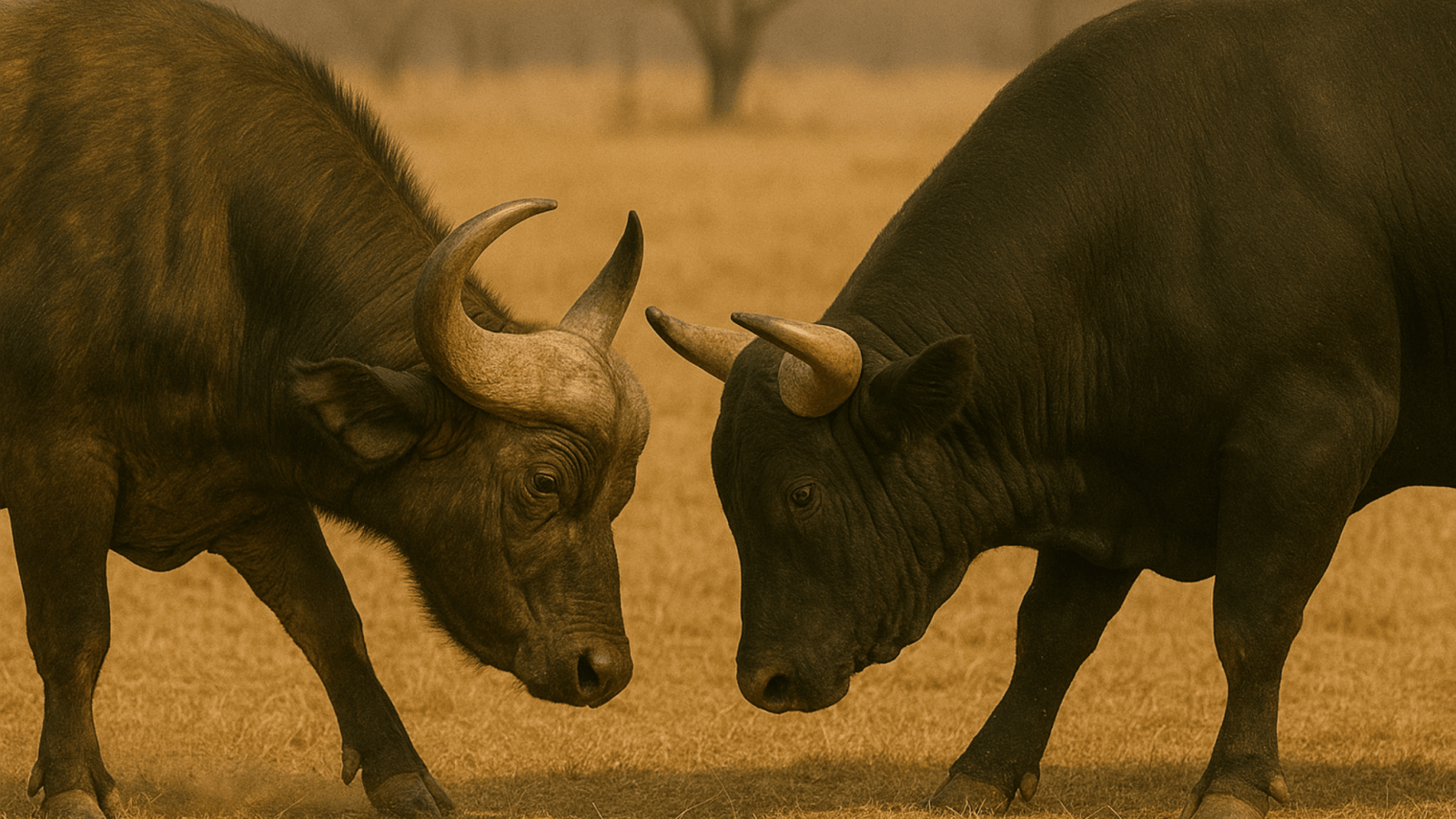
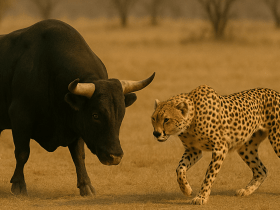
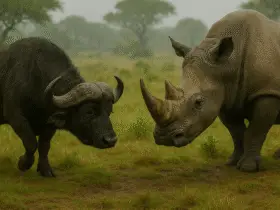
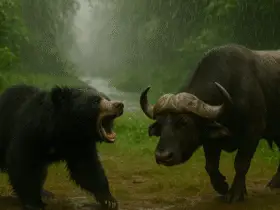
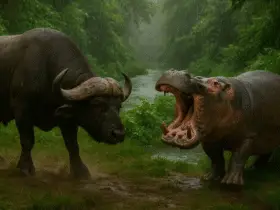
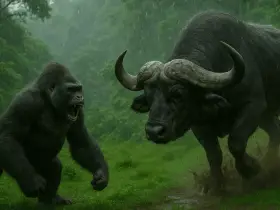
Leave a Reply